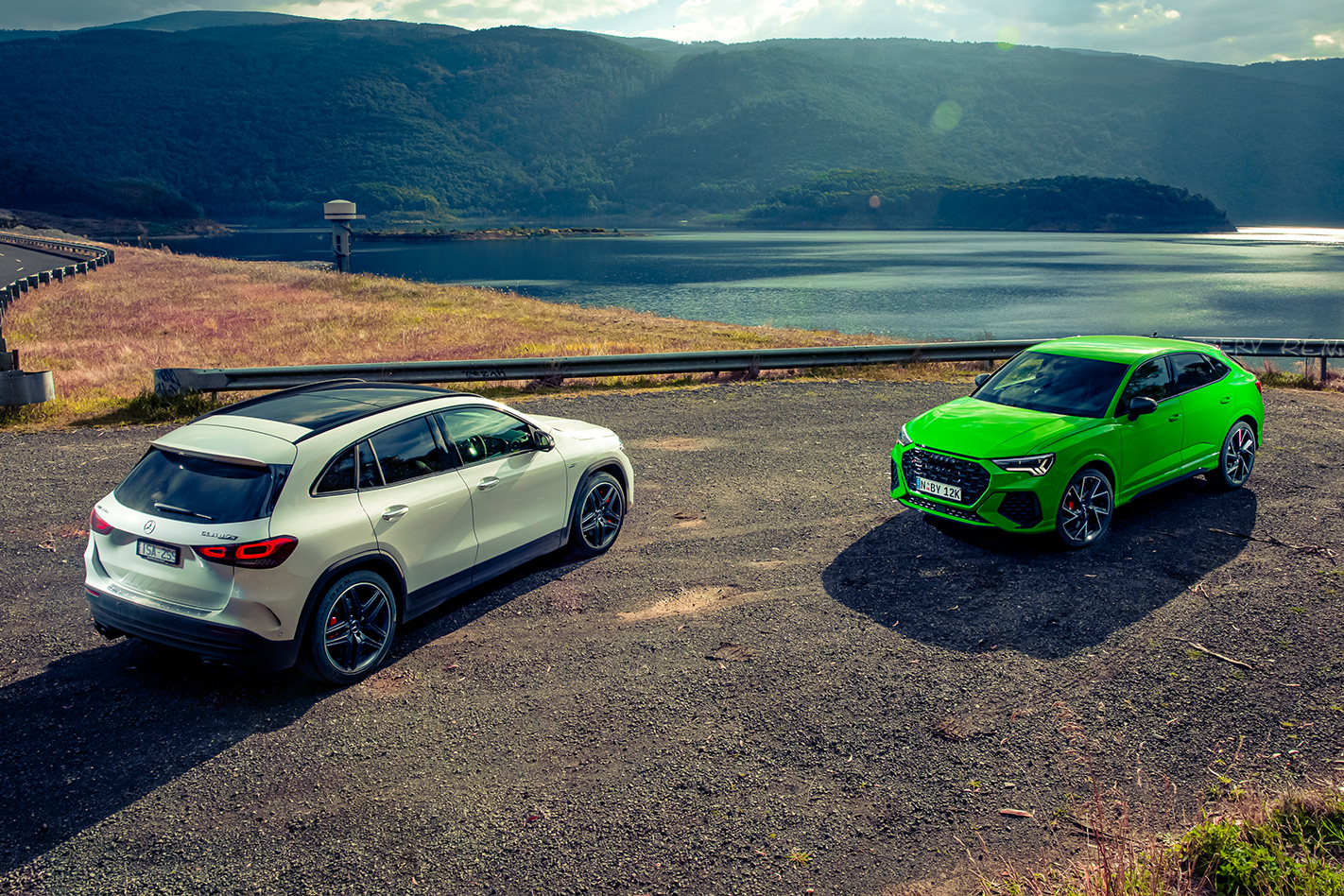Take this as your official warning: if you see a Mercedes-AMG GLA 45 S or Audi RS Q3 lurking around the bottom of a twisting mountain road, do not try and outrun them unless you are packing a serious piece of equipment. No, your Porsche 997 911 Turbo, or HSV Clubsport GTS may not suffice. You will be harassed and taunted by these little SUVs until your brakes are steaming, and tyres wailing like a wild hog.
The days of SUVs being doggedly compromised, dynamically incompetent lightning rods for those that have given up on life, and joy, are long gone.
Both of the contenders you see before you are more powerful than a Ferrari 360, and the manufacturers claim 0-100km/h times in the mid-four-second bracket. These aren’t your Aunt Linda’s baby SUV. How we ended up in a situation where two small crossovers can embarrass the performance car benchmarks of old is a curious combination of marketing cynicism, never-say-die engineering, and demanding customers.
The Mercedes-AMG GLA 45 S and Audi RS Q3 weren’t created in a vacuum. A bunch of people in suits saw the popularity of the A45 S and RS3 hyper hatches, noted the relentless rise of the small SUV segment, and the inevitable happened. We have extremely talented development teams to thank for the fact the results aren’t a wallowing mess. Our job today is to answer two questions: how easy are these baby performance SUVs to justify against their hyper hatch equivalents, and do they possess the talents of a proper performance car?

While both are relatively box-fresh, the AMG is the newer of the pair, being released earlier this year. The centrepiece is the M139 turbocharged four-cylinder engine, which produces identical outputs of 310kW and 500Nm to the A45 S which just scalped a podium spot at PCOTY 2021. You’ll need to pay for the privilege of moving to the SUV from the hatch though, with the GLA 45 S wearing a freshly increased sticker price of $108,100.
The Audi is only slightly older, being launched locally late last year, and it enters the fight as the pre-event underdog. Capacity is up compared to AMG (2.5-litres v 2.0), with an extra cylinder to boot, but the five-pot tops out at 294kW and 480Nm. This isn’t a game of power top trumps though, with the Audi being lighter and cheaper.
It also has four decades of legendary heritage in that quattro badge on the boot. In the rakish Sportback version of our test car, customers will need $92,900 to add one to their driveway. The only options fitted to NBY12K are cosmetic (black badging, interior carbon inlays, and carbon mirror housing), but the Kyalami Green Audi remains the more affordable vehicle at $95,750 all up. The non-Sportback version only widens that price difference with a $89,990 sticker, while also clawing back some extra practicality by ditching the swooping rear roofline.
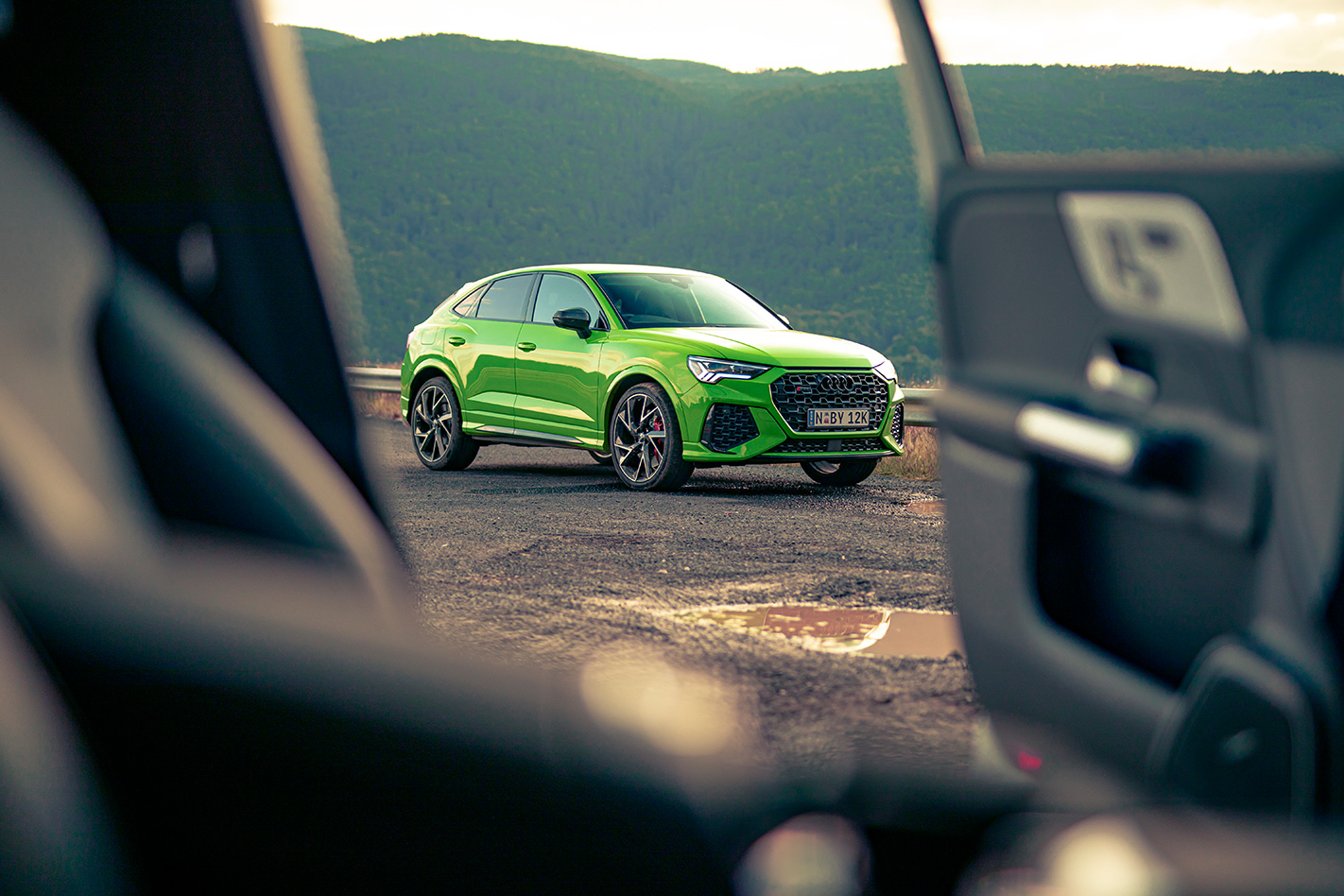
Yes, the AMG is more expensive, but there are plenty of advantages in that, with powered front seats instead of manual, a panoramic sunroof and head-up display part of the spec sheet bonuses that make the GLA more pleasant day-to-day. Spend time in both and its easy to see that regular useability is more of a priority compared to their hatch equivalents, exemplified by the lack of such extrovert side bolstering on the lower portion of the seats, and a low-down power delivery that’s been dialled back a little by the software engineers.
With all the settings set to angry, but without activating launch control, neither the Merc nor Audi really leap off the line. Both gradually roll through the first couple thousand RPM like an old-school heavily turbocharged car. The GLA lights up first, coming alive from around 2500rpm and never relenting through the rev range.
In the wet it’ll spin all four tyres in the first couple of gears. Audi’s larger-capacity engine takes longer to wind up, only hitting its stride nearer 4000rpm. Even then, power delivery is calmer and more progressive. The ferocity of the A45 S and RS3 from a dig tells us that the issue for both contenders is artificially electronic, not lag related. Using customisable drive modes rectifies this issue somewhat, but there is no escaping the tamping down of power delivery designed to make these more palatable for everyday use. Perhaps that’s no bad thing.
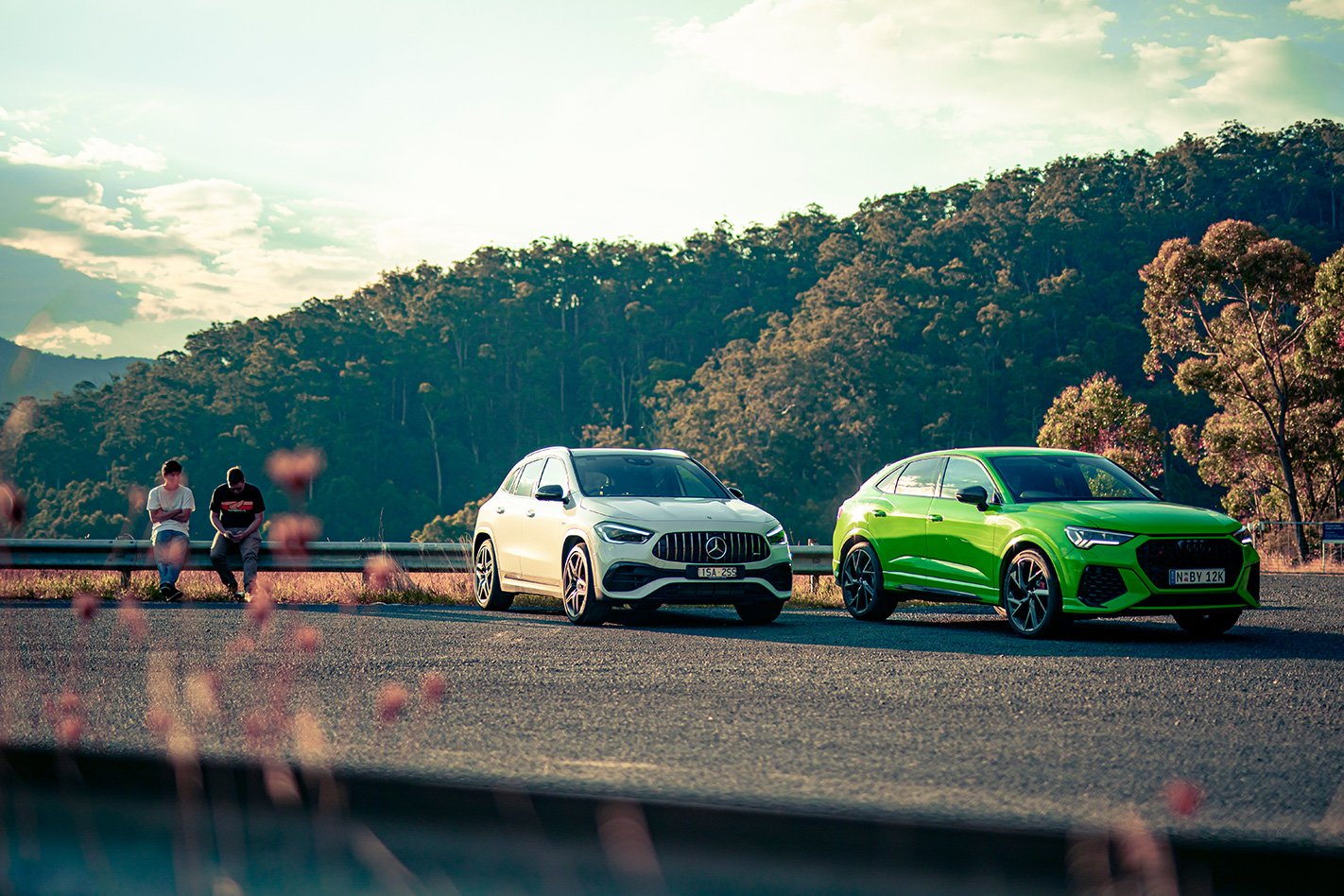
But we aren’t about to get bogged down in everyday practicalities. This is about the pair’s performance credentials, and to answer why you should opt for one of our contenders over a traditional hatch we need something more than a great tarmac driving road. We need some dirt.
On the eastern side of Victoria’s Yarra Ranges National Park lays Thomson Dam. If you head north toward this body of water from Moe, you’ll pass a junction that regular driving enthusiasts ignore – marked as South Face Road. Most frequently traversed by logging trucks and trail bike riders, the almost entirely unsealed route ascends for 29 kilometres toward Mt Baw Baw Village, filled with groomed gravel and a combination of sweeping open bends, and tight, technical hairpins.
You could take an A45 S or RS3 onto this road, but it’d be a grimace-heavy experience. However, the extra millimetres of ride height and less focused rubber of these baby SUVs transform them into the gravel-spec equivalents of their Monaco Rally tarmac-ready hatch siblings. Wait for the loggers and truckies to knock off for the day, and South Face Road turns into the perfect playground to explore the GLA 45 S and RS Q3’s hidden merits.
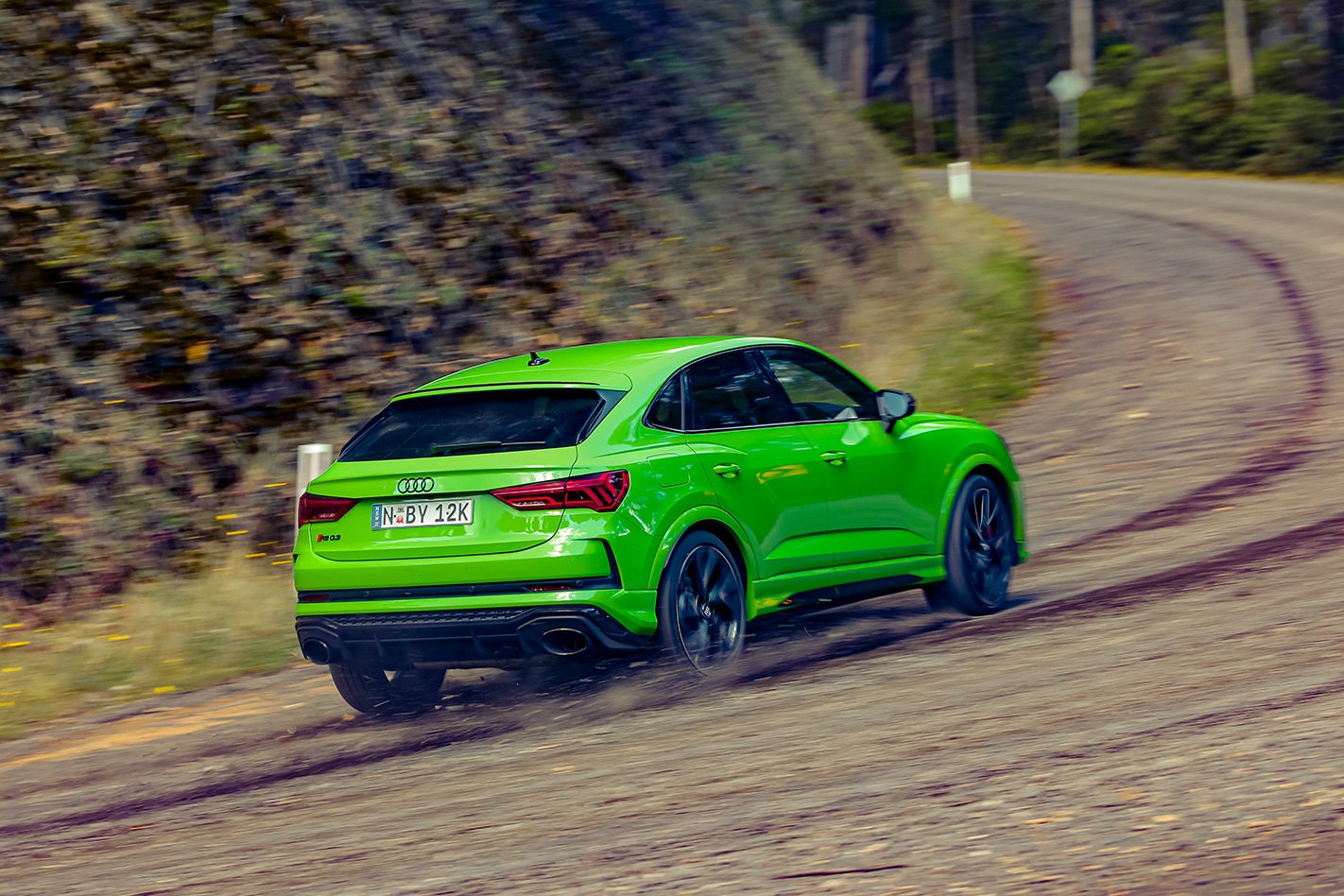
While both are a riot, there is a clear divergence in character between them on dirt. We decided to level the playing field by selecting an ESC Sport mode on both cars. The Audi feels at peace spitting gravel at our photographer. It rotates surprisingly eagerly on corner entry, happy to turn on its axis with a lift of the throttle, or a meandering Scandi-flick if you really want to grab it by the scruff.
The electrical nannies will allow some decent angles before interfering, but they’ll need reassuring that you’re dialling in the right amount of lock behind the wheel. Despite its heft (1775kg) and taller centre of gravity compared to a hatch, the RS Q3 transfers its weight with poise, allowing you to link bends more naturally.
This is in contrast to the AMG, which feels more planted and unwilling to become unstuck without aggressive weight transfer, the ESC keen to intervene and prevent any lift-off antics. The systems puts it trust in the driver on corner exit, deploying the M139’s power to great effect. It also lacks the poise of the Audi on transitions, keen to pull itself straight with any throttle application instead of flowing from side-to-side.
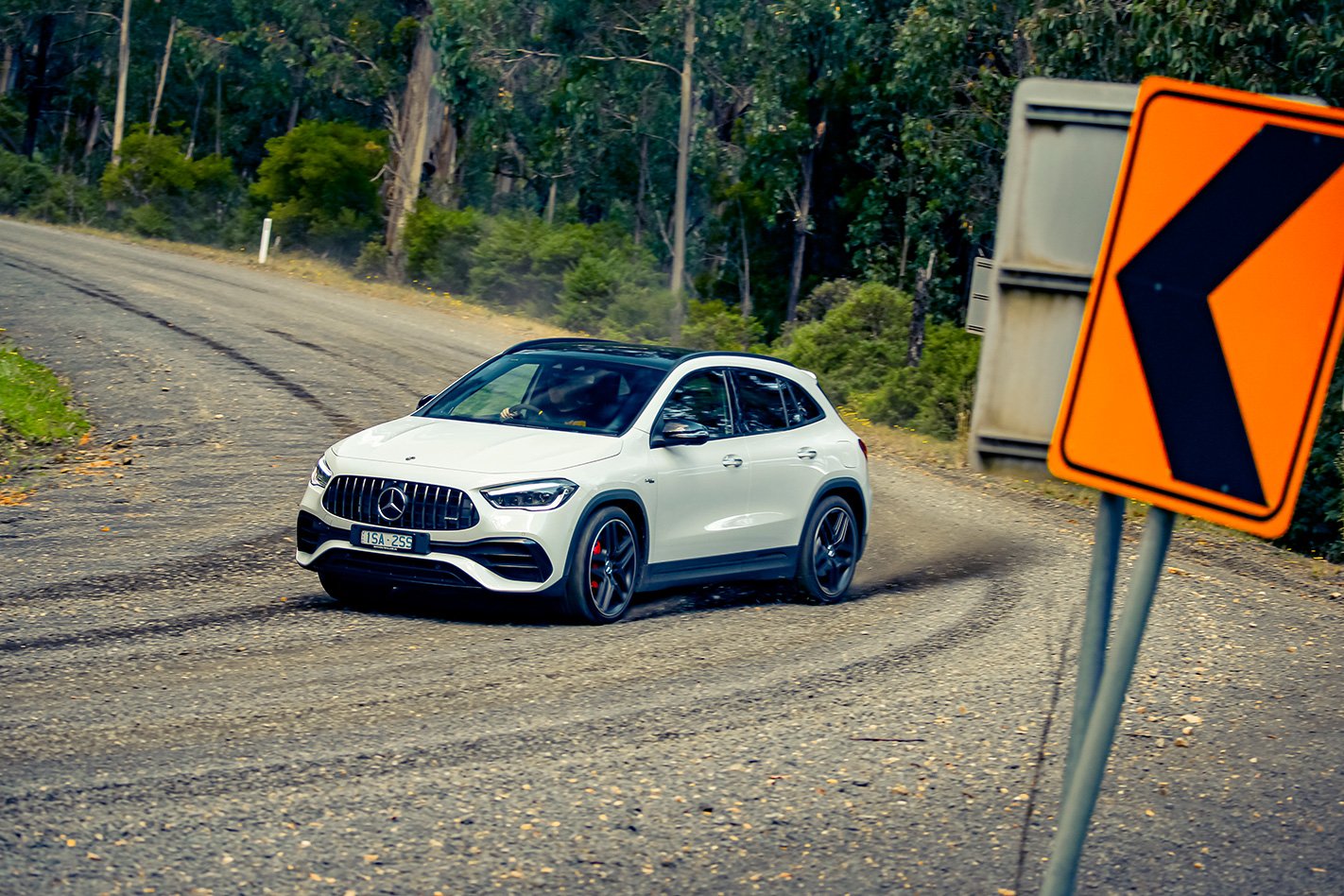
Once you’ve got it on its toes, the AMG is less frantic inside the cabin and the GLA 45 S will allow long four-wheel slides with barely any steering correction required. However, the RS Q3 lives up to its quattro heritage, possessing a character that is a little more unbuttoned and more at home with the concept of offering the keen driver options on a loose surface. Early advantage to the Audi, then.
Dusty shenanigans complete we travel back down South Face Road and complete our journey toward Thomson Dam, the road slowly transforming and tightening as it descends toward the dam wall. Being a barrel of laughs on a loose surface is easy, but can either of these baby SUVs thrill on a typically winding, bumpy, challenging Aussie B-road?
The steering in the Audi is quick, with the variable ration taking from 2.1 turns lock-to-lock, but avoids being too darty. Though it is on the lighter side – even in its most dynamic setting – it remains direct and accurate, with little to no dead zone. Neither the RS Q3 or GLA 45 S are the last word in steering feel and communication, but the lack of heft to the Audi’s rack can take longer to adjust to as it hides more subtle transmissions.
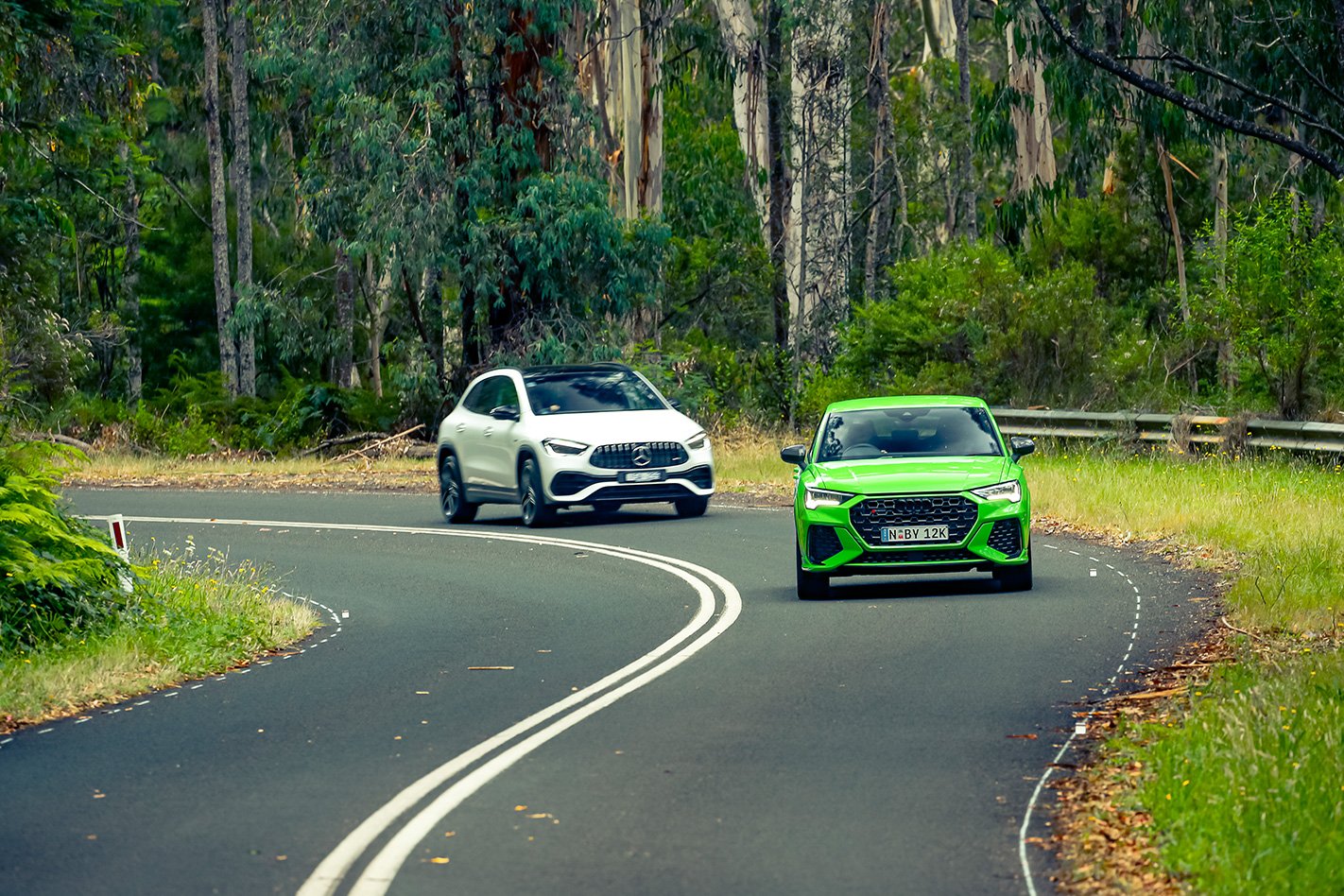
Though it disguises its weight adequately, the Audi’s body control can’t match the AMG’s, making its SUV nature more prominent than the GLA. Its primary ride is respectable for a tall car with this focus, swallowing mid-corner bumps skillfully.
When hustling the RS Q3 it becomes clear plenty of thought has been put into the chassis. It has a refined, neutral character, and if you are judicious with the speed of turn-in, the little SUV will happily carry impressive corner speed, flowing and dancing through the bends.
Praise needs to be heaped upon to the engineers at Neckarsulm who were able to slice 30kg of heft from the RS Q3 compared to the previous generation, with 26kg coming straight off the nose due to a new alloy crankcase design for the five-pot engine. Bends with a tightening radius do remain a challenge, however, with a delicate balance off throttle and light braking required to hook in without pushing the front wide.
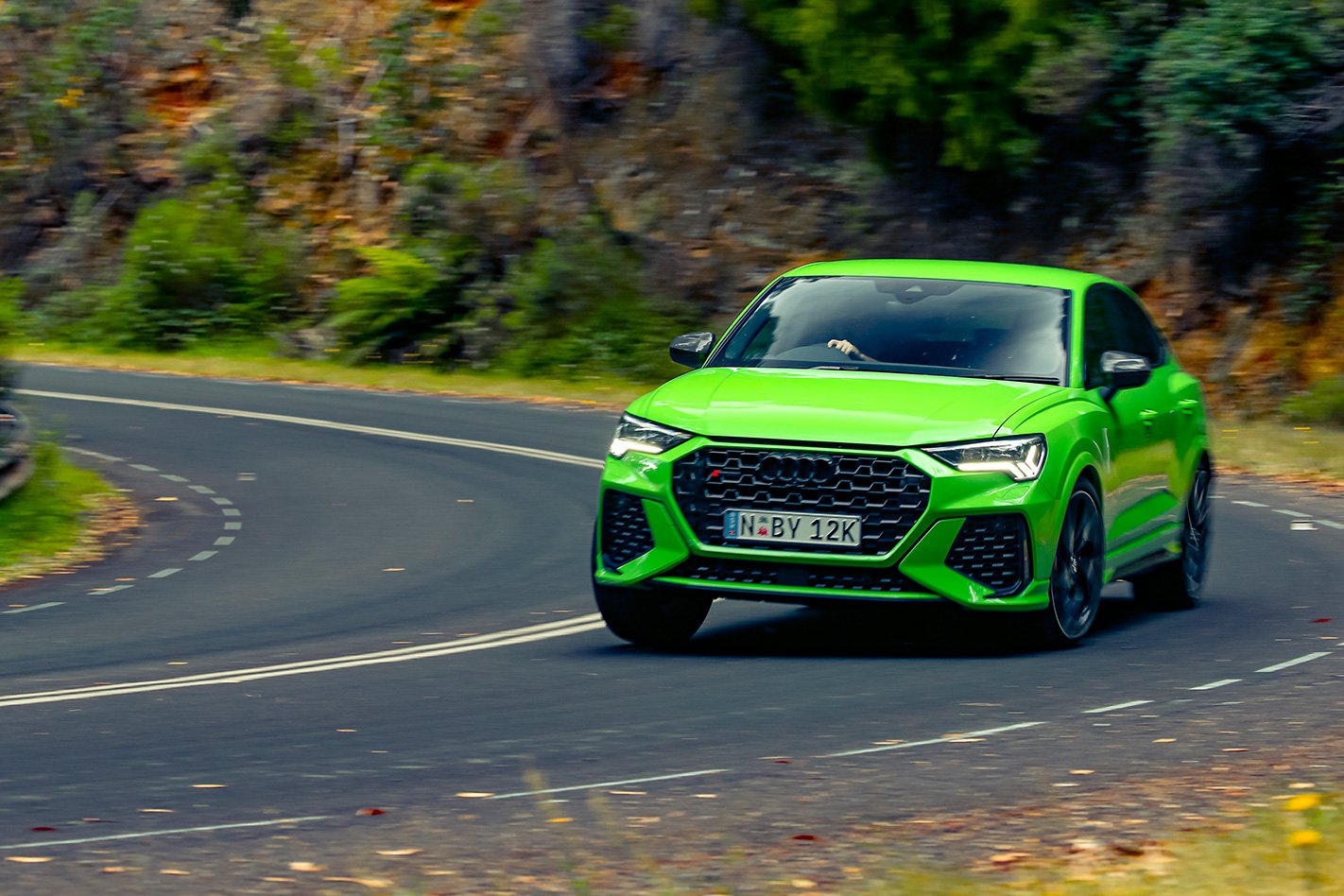
Now for the fall. The RS Q3’s Achilles heel is its gearbox, with the seven-speed dual-clutch transmission doing its utmost to take the edge off the driving experience at almost every turn. Even in its most aggressive dynamic setting it feels overwhelmed, with confounding gear choices and delayed shifts. Somehow it gets worse in manual mode, often refusing reasonable downshifts on corner entry, and then on upshift, suffering agonising delays between pulling the paddle and the next ratio being engaged.
Then there is the Mercedes, which opens with a gut punch and never relents. Driving the GLA 45 S fast is a brutal, theatrical display of chassis engineering. Where the RS Q3 is unable to hide its SUV nature, the GLA drives and performs like a slightly larger hot hatch. The meatier steering provides greater feel and you need it, as the AMG takes a dislike to remedial lock being added mid corner. The AMG’s suspension is stiffer than the Audi’s in its firmest setting, and its roll stiffness is beefier too.
However, you aren’t completely sacrificing bump absorption, with the pocket rocket maintaining composure – and pace – over nasty mid-corner bumps. Like the A45 S, it is fairly loud on a highway schlep though.
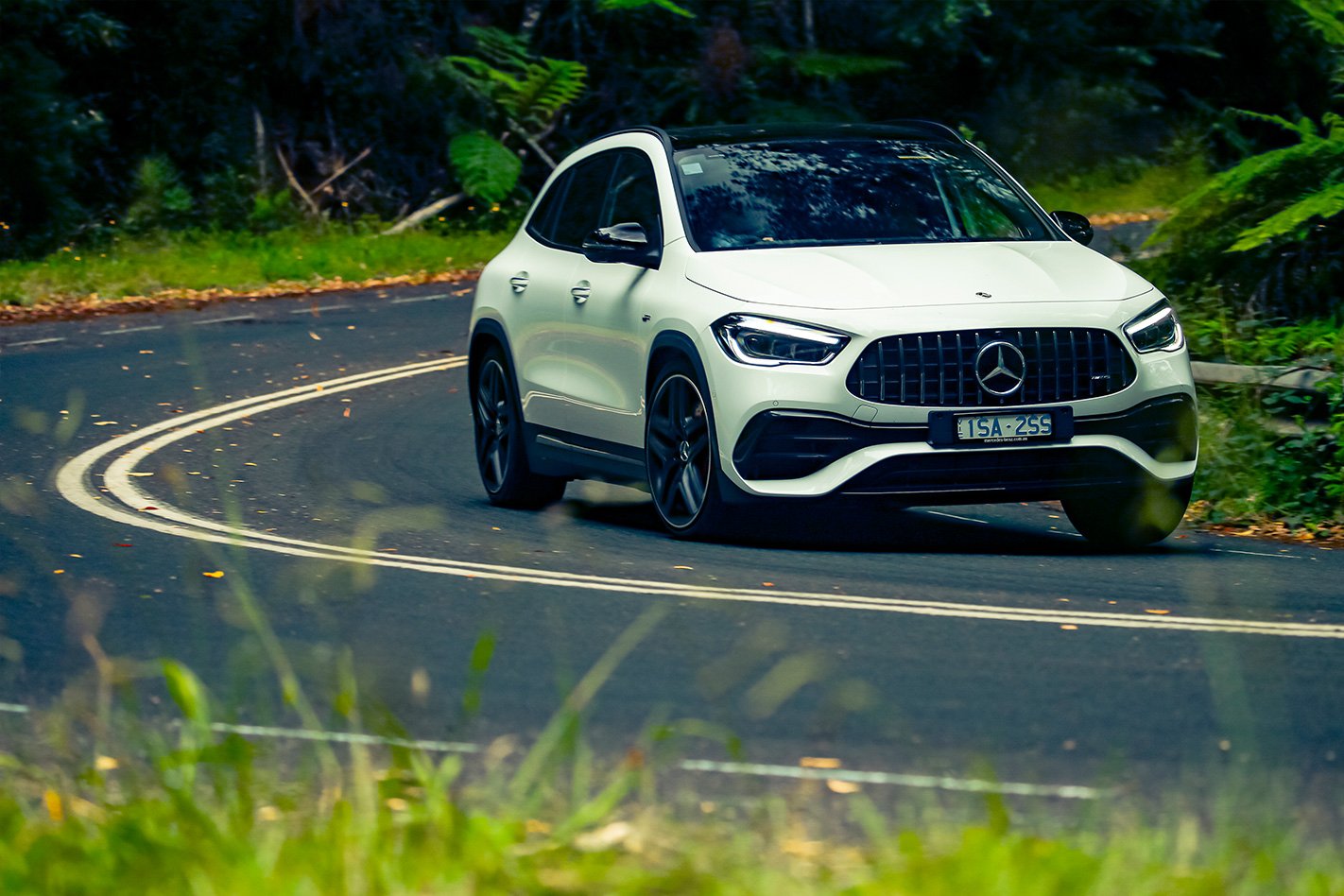
Despite ceding around half a litre in swept capacity to the Audi, the AMG’s power delivery is in another league. Any on-paper low-rpm torque deficit is blown into irrelevance on tarmac. Corner exits allow for nibbles of power oversteer in the most liberal ‘Master’ dynamic setting. We’ve said it before, and we’ll say it again – the M139 is one of the most impressive internal combustion engines ever built, regardless of cylinder count.
Where the Audi comes with a poorly calibrated transmission, the AMG excels. Mercedes’ eight-speed dual-clutch transmission is brilliant. Left to its own devices the automatic setting is intuitive, selecting the right ratio for the right moment almost instinctively.
Switch to manual mode and it gets even better, with rapid shifts both up and down ratios handed out on command. The joy of the AMG’s system is that it will willingly serve you any ratio as long as it is capable – meaning it’ll provide you a downshift right onto redline. The benefit of the large, bright head-up display is also keenly felt, with shift lights displayed within your eyeline. You’ll initially need them too, as the engine rushes to its rev-cut with genuine ferocity.
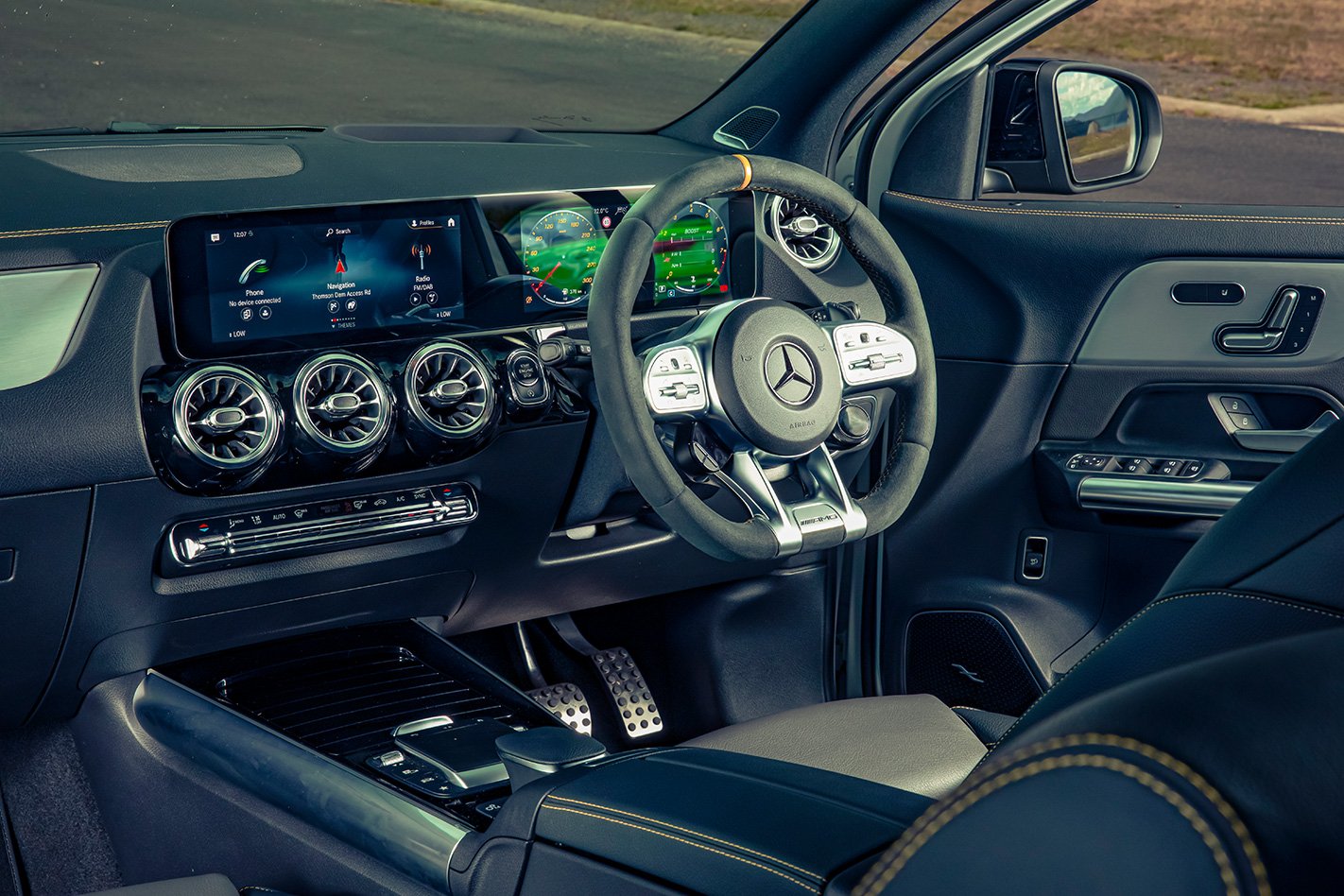
The gear ratios are more closely stacked in the AMG and, on our test route at least, they seemed better judged. On this serpentine b-road, third gear does the lion’s share of the work, where the Audi has you constantly shifting between second and third at the same speeds. If you do need a gear change in the GLA, the shift is quick and crisp, and accompanied by a wonderful whip-like crack from the exhaust in sportier drive modes.
The shortcomings of Audi’s transmission also mean it fails to return serve in a straight line. While neither could quite match their claims on the day (AMG 4.3, Audi 4.5), the GLA was closest with a 4.5-second sprint to 100km/h while the RS Q3 took 5.0-seconds flat. The AMG’s ratios see it ripping through shifts noticeably swifter than the Audi. There is half a second between them at the end of the quarter mile, but after 400 metres the AMG has an almost 10km/h speed advantage. It is more potent, more often and you feel it behind the wheel.
That’s the deciding factor here. If you were a fiend for dirt, we’d recommend the RS Q3 every day, but the Audi’s advantage on loose surfaces isn’t enough to stop the AMG levering itself into a winning position on bitumen.
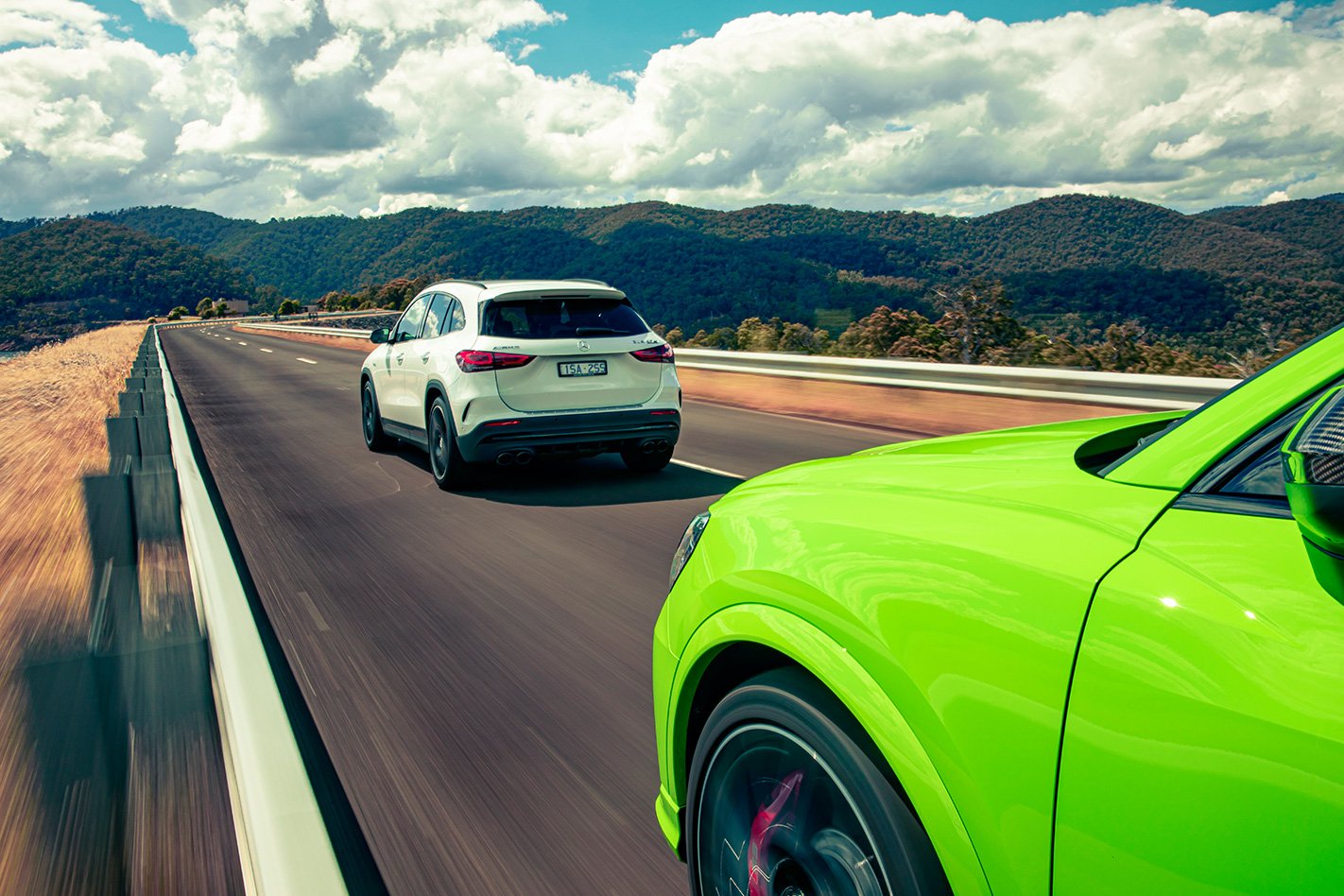
The GLA is simply more focused and capable, hiding its SUV design with hatch-like dynamic characteristics, capable of higher-highs than the RS Q3 on tarmac at every turn. AMG hasn’t completely lost the SUV benefits in the process either, with the baby Merc remaining good fun on dirt, refined and comfortable around town, but capable of haunting the thoughts of Porsche owners on a winding back road.
Best of both worlds? It’s right here.
Power Shuffle
AMG has fitted the GLA 45 S with the same 4Matic+ all-wheel drive system that is used on the A45 S, using a pair of multi-plate clutches on the rear axle to move power to whichever side needs it most. The system is also capable of sending up to 100 per cent of power to the rear wheels only.
Where Mercedes shuffles its grunt laterally using the drivetrain, Audi employs what it calls ‘wheel-selective torque control’ which is a braked torque-vectoring system. When moving power fore and aft a Haldex-based central multi-plate clutch is used, capable of shuffling up to 85 per cent of grunt to the rear. However, the system remains predominately front-biased in normal driving conditions.
A la mode
You can customise a slew of different drive settings in both cars, but they go about it in intriguingly different ways. Adjusting on the fly in the AMG is a breeze with a dial on the wheel allowing you to flick between the five ‘standard’ drive modes. To switch between the RS Q3’s four regular settings you have to use a button on the dash above the climate controls.
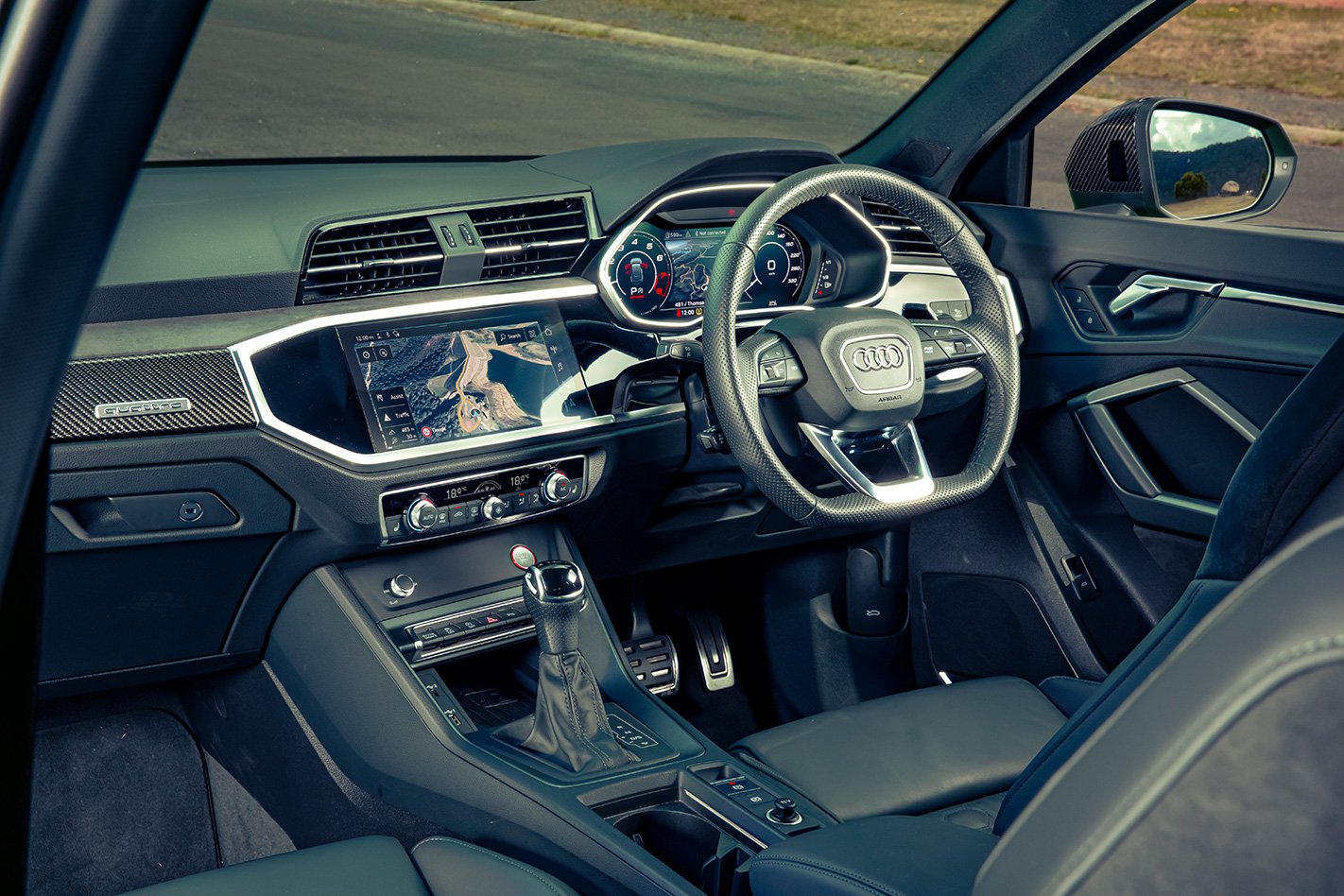
While engine and gearbox modes are linked in the AMG, the Audi will allow these to be mixed and matched. Additionally, the RS Q3 has two individualised settings to the AMG’s one. However, you must use the touch screen to activate them, where in the GLA simply pressing the wheel-mounted dial switches the car instantly to your preferred drive settings.
Technical Specs
Audi RS Q3
Body: 5-door, 5-seat SUV Drive: all-wheel Engine: 2480cc inline-5, DOHC, 20v, turbo Bore x Stroke: 82.5 x 92.8mm Compression: 10.0:1 Power: 294kW @ 5850-7000rpm Torque: 480Nm @ 1980-5850rpm Power/Weight: 166kW/tonne Transmission: 7-speed dual-clutch Weight: 1775kg Suspension: MacPherson strut, coil spring, anti-roll bar, adaptive dampers (f) multi-link, coil spring, anti-roll bar, adaptive dampers (r)
L/W/H: 4507/1851/1557mm Wheelbase: 2681mm Tracks: 1590/1583mm Steering: electrically assisted rack-and-pinion Brakes: 375mm ventilated discs, 6-piston fixed calipers (r), 310mm ventilated discs, single piston floating calipers (r)
Wheels: 21 x 8.5-inch (f/r) Tyres: 255/35/21 (f/r) Continental SportContact 6
Price: $92,900 ($95,750 as tested) Pros: Chassis balance; loose surface thrills Cons: Clumsy gearbox; light steering Rating: 3.5/5
Mercedes-AMG GLA 45 S
Body: 5-door, 5-seat SUV Drive: all-wheel Engine: 1991cc inline-4, DOHC, 16v, turbo Bore x Stroke: 83.0 x 92.0mm Compression: 9.0:1 Power: 310kW @ 6750rpm Torque: 500Nm @ 5000-5250rpm Power/Weight: 175kW/tonne Transmission: 8-speed dual-clutch Weight: 1807kg Suspension: MacPherson strut, coil spring, anti-roll bar, adaptive dampers (f) multi-link, coil spring, anti-roll bar, adaptive dampers (r)
L/W/H: 4438/1849/1581mm Wheelbase: 2729mm Tracks: 1605/1605mm Steering: electrically assisted rack-and-pinion Brakes: 360mm ventilated discs, 6-piston fixed calipers (r), 330mm ventilated discs, 4-piston fixed calipers (r)
Wheels: 20 x 8.5-inch (f/r) Tyres: 255/40/20 (f/r) Continental SportContact 6
Price: Price: $108,100 Pros: Relentless grunt; swift shifts; car-like ability Cons: Price premium; awkward weight transfer Rating: 4.0/5
%MCEPASTEBIN%


